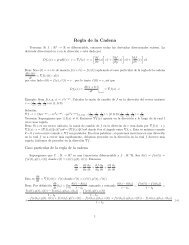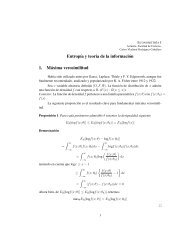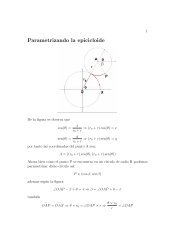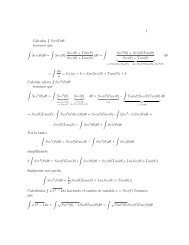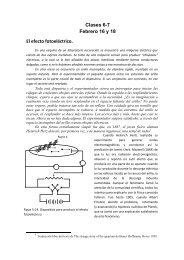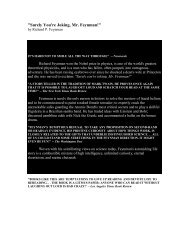Teorema de la Función Impl´ıcita
Teorema de la Función Impl´ıcita
Teorema de la Función Impl´ıcita
You also want an ePaper? Increase the reach of your titles
YUMPU automatically turns print PDFs into web optimized ePapers that Google loves.
<strong>Teorema</strong> <strong>de</strong> <strong>la</strong> <strong>Función</strong> Implícita<br />
El círculo <strong>de</strong> radio 1 con centro en el origen, pue<strong>de</strong> representarse implícitamente mediante <strong>la</strong> ecuación<br />
x 2 + y 2 = 1 ó explícitamente por <strong>la</strong>s ecuaciones y = √ 1 − x 2 y y = − √ 1 − x 2 o paramétricamente por<br />
<strong>la</strong>s ecuaciones x = cos t y y = sin t con 0 ≤ t ≤ 2Π.<br />
En general, una representación implícita <strong>de</strong> una curva <strong>de</strong>l p<strong>la</strong>no xy esta dada por una so<strong>la</strong> ecuación<br />
en x,y <strong>de</strong> <strong>la</strong> forma f(x,y)=0.<br />
Una representación explícita <strong>de</strong> una curva <strong>de</strong>l p<strong>la</strong>no xy esta dada por un par <strong>de</strong> ecuaciones que expresan<br />
y en términos <strong>de</strong> x ó x en términos <strong>de</strong> y y son <strong>de</strong> <strong>la</strong> forma y=g(x) ó x=g(y).<br />
Una representación paramétrica <strong>de</strong> una curva <strong>de</strong>l p<strong>la</strong>no esta dada por un par <strong>de</strong> ecuaciones que expresan<br />
x y y en términos <strong>de</strong> una tercera variable, que con frecuencia <strong>de</strong> <strong>de</strong>nota por t.<br />
Ejemplo:<br />
Encuentre en representaciones implícitas, explícitas y paramétricas <strong>de</strong> <strong>la</strong> recta que pasa por (3,0) y<br />
(0,5):<br />
x y<br />
+ = 1 (Implícita)<br />
3 5<br />
y = 5 − 5<br />
x (Explícita)<br />
3<br />
x = 3t, y = 5 − 5t (Paramétrica)<br />
Ejemplo:<br />
Encuentre una representación implícita y una explícita <strong>de</strong> <strong>la</strong> curva x = 3 + 5 sin t, y = 1 + 2 cos t<br />
con 0 ≤ t ≤ 2Π<br />
x − 3<br />
= sin t,<br />
5<br />
( y − 1<br />
2 )2 <br />
= ( 1 −<br />
y − 1<br />
2<br />
= cos t ⇒ (x − 3)2<br />
5 2<br />
(x − 3)2<br />
)(±2) + 1<br />
25<br />
+ (y − 1)2<br />
2 2<br />
= 1 (Elipse)<br />
Las paramétricas y <strong>la</strong>s explícitas son más fáciles <strong>de</strong> graficar, pero pue<strong>de</strong> ocurrir que no podamos <strong>de</strong>spejar<br />
y en términos <strong>de</strong> x , pero muchas veces po<strong>de</strong>mos sustituir <strong>la</strong> ecuación por una aproximación<br />
lineal válida cerca <strong>de</strong> un punto. De esta aproximación, por lo general, se pue<strong>de</strong> <strong>de</strong>spejar y . Por lo tanto,<br />
cerca <strong>de</strong> un punto en particu<strong>la</strong>r, una ecuación implícita suele <strong>de</strong>finir una aproximación lineal explícita.<br />
Ejemplo:<br />
El punto (1, 1) esta en <strong>la</strong> curva y 3 + x 2 y + x 3 = 3. Encontrar una ecuación lineal explícita que <strong>de</strong><br />
una buena aproximación para el tramo <strong>de</strong> <strong>la</strong> curva cerca <strong>de</strong>l punto (1, 1).<br />
1
Solución:<br />
Consi<strong>de</strong>ramos <strong>la</strong> función f(x, y) = y 3 + x 2 y + x 3 que cerca <strong>de</strong>l (1, 1) es<br />
f(x, y) = f(1, 1) + fx(1, 1)(x − 1) + fy(1, 1)(y − 1) = 3 + 5(x − 1) + y(y − 1).<br />
La curva tiene por ecuación f(x, y) = 3, así que cerca <strong>de</strong>l punto (1, 1) esta aproximada cercanamente por<br />
3 + 5(x − 1) + y(y − 1) = 3 que al <strong>de</strong>spejar y resulta y = 1 − 5<br />
(x − 1). Esta es <strong>la</strong> ecuación para <strong>la</strong> recta<br />
y<br />
tangente a <strong>la</strong> curva en el punto (1, 1).<br />
Para dimensiones mayores por ejemplo <strong>la</strong> esfera <strong>de</strong> radio 1 con centro en el origen pue<strong>de</strong> representarse<br />
implícitamente por x 2 + y 2 + z 2 = 1 ó z = 1 − x 2 − y 2 y z = − 1 − x 2 − y 2 ó<br />
x = sin φ cos θ, y = sin φ sin θ, z = cos φ con 0 ≤ θ ≤ 2Π, 0 ≤ φ ≤ 2Π.<br />
Importante: Las curvas en 3 dimensiones no se pue<strong>de</strong>n representar explícita o implícitamente porque<br />
una so<strong>la</strong> ecuación en 3 variables por lo general <strong>de</strong>scribe una superficie. Sin embargo, <strong>la</strong>s curvas en el<br />
espacio pue<strong>de</strong>n expresarse paramétricamente. Por ejemplo, una hélice en el cilindro <strong>de</strong> radio 1 con centro<br />
en el eje z se pue<strong>de</strong> <strong>de</strong>scribir paramétricamente con x = cos t, y = sin t, z = t con −∞ < t < ∞.<br />
Ejemplo:<br />
Mostrar que <strong>la</strong> ecuación implícita z 3 − 7yz + 6e x = 0 no <strong>de</strong>fine z como función <strong>de</strong> x y y.<br />
Consi<strong>de</strong>remos x = 0, y = 1 y obtenemos z 3 − 7z + 6 = 0 ⇒ (z − 2)(z − 1)(z + 3) = 0<br />
Por lo tanto, tenemos 3 soluciones, z no es función <strong>de</strong> x y y.<br />
Este ejemplo muestra que si z 3 − 7yz + 6e x = 0, entonces no po<strong>de</strong>mos esperar escribir z como función<br />
explícita <strong>de</strong> x y y pero aún po<strong>de</strong>mos escribir z como función explícita <strong>de</strong> x y y en parte <strong>de</strong> <strong>la</strong> gráfica.<br />
La gráfica <strong>de</strong> <strong>la</strong> ecuación z 3 − 7yz + 6e x = 0 es una superficie, y en el<strong>la</strong> tengo a (0,1,2), (0,1,1) y<br />
(0,1,-3). Esperamos encontrar funciones z = f1(x, y), z = f2(x, y), z = f3(x, y) tales que f1 indique<br />
puntos en <strong>la</strong> superficie cerca <strong>de</strong> (0,1,2), f2 cerca <strong>de</strong> (0,1,1) y f3 cerca <strong>de</strong> (0,1,-3).<br />
1) Encontrar f1(0, 1), f2(0, 1), f3(0, 1).<br />
Como f1 indica valores <strong>de</strong> z cerca <strong>de</strong>l punto (0,1,2) tenemos f1(0, 1) = 2, en forma análoga f2(0, 1) = 1 y<br />
f3(0, 1) = −3.<br />
2) Para calcu<strong>la</strong>r f1(0.02, 1.01) sustituimos x = 0.02, y = 1.01 en z 3 − 7yz + 6e x = 0 y obtenemos<br />
z 3 − 7.07z + 6e 0,02 = 0 cuyas soluciones son z = 2.0038, z = 1.0127, z = −3.0165.<br />
Por lo tanto, f1(0.02, 1.01) = 2.0038, f2(0,02, 1,01) = 1,0127, f3(0.02, 1.01) = −3.0165, por lo que<br />
2
f1, f2, f3 estan bien <strong>de</strong>finidos para x cerca <strong>de</strong> cero y y cerca <strong>de</strong> 1.<br />
La tarea es encontrar una función lineal explícita ℓ que aproxime f1 cerca <strong>de</strong> (0,1,2) y comparar el valor<br />
dado en esta aproximación a los valores f1(0, 1) y f1(0.02, 1.01).<br />
Suponga f(x, y, z) = z 3 − 7yz + 6e x = 0<br />
fx = 6ex ⇒ fx| (0,1,2) = 6<br />
fy = −7z ⇒ fy| 0,1,2) = −14<br />
fz = 3z 2 − 7y ⇒ fz| (0,1,2) = 5<br />
Por lo tanto <strong>la</strong> aproximación lineal F cerca <strong>de</strong> (0,1,2) es<br />
F (x, y, z) = F (0, 1, 2) + Fx(0, 1, 2)(x − 0) + Fy(0, 1, 2)(y − 1) + Fz(0, 1, 2)(z − 2)<br />
y como F (0, 1, 2) = 0<br />
F (x, y, z) ≈ 0 + 6x − 14(y − 1) + 5(z − 2)<br />
y al ser F (x, y, z) = 0<br />
0 ≈ 6x − 14(y − 1) + 5(z − 2)<br />
z ≈ −0.8 − 1.2x + 2.8y<br />
por lo que ℓ(x, y) = −0.8 − 1.2x + 2.8y<br />
así ℓ(0, 1) = 2 y ℓ(0.02, 1.01) = 2.04<br />
<strong>Teorema</strong> <strong>de</strong> <strong>la</strong> <strong>Función</strong> Implícita (1a Versión)<br />
Consi<strong>de</strong>re <strong>la</strong> función z = f(x, y). Sea (x0, y0) ∈ R2 un punto tal que F (x0, y0) = 0. Suponga que <strong>la</strong><br />
función F tiene <strong>de</strong>rivadas parciales continuas en alguna bo<strong>la</strong> con centro (x0, y0) y que ∂F<br />
∂y (x0, y0) = 0.<br />
Entonces F (x, y) = 0 se pue<strong>de</strong> resolver para y en términos <strong>de</strong> x y <strong>de</strong>finir así una función y = f(x) con<br />
dominio en una vecindad <strong>de</strong> x0, tal que y0 = f(x0), lo cual tiene <strong>de</strong>rivadas continuas en V que pue<strong>de</strong>n<br />
∂F<br />
(x, y)<br />
calcu<strong>la</strong>rse como y ′ = f ′ (x) = −<br />
∂x<br />
∂F<br />
(x, y)<br />
∂y<br />
, x ∈ V.<br />
Importante: Este es un resultado que garantiza <strong>la</strong> existencia <strong>de</strong> una función y = f(x) <strong>de</strong>finida implícitamente<br />
por F (x, y) = 0. Esto es, pue<strong>de</strong> resolverse para y en términos <strong>de</strong> x, pero no nos dice como<br />
hacer el <strong>de</strong>speje.<br />
Ejemplo:<br />
Consi<strong>de</strong>re <strong>la</strong> función f(x, y) = e 2y+x + sin(x 2 + y) − 1 en el punto (0,0) tenemos F (0, 0) = 0. Las<br />
3
<strong>de</strong>rivadas parciales <strong>de</strong> F son<br />
Fx = e 2y+x + 2x cos(x 2 + y)<br />
Fy = 2e 2y+x + cos(x 2 + y) que son siempre continuas.<br />
A<strong>de</strong>más, ∂F<br />
(0, 0) = 3 = 0 <strong>de</strong> modo que T.F.Im. garantiza una vecindad <strong>de</strong> x = 0 en <strong>la</strong> cual po<strong>de</strong>mos<br />
∂y<br />
<strong>de</strong>finir una función y = f(x) tal que F (x, f(x)) = 0. Obsérvese que en este caso no po<strong>de</strong>mos hacer<br />
explícita <strong>la</strong> función y = f(x) sin embargo tal función existe y su <strong>de</strong>rivada es<br />
y ′ = f ′ (x) = −<br />
Ejemplo:<br />
∂F<br />
∂x<br />
∂F<br />
∂y<br />
= e2y+x + 2x cos(x 2 + y)<br />
2e 2y+x + cos(x 2 + y)<br />
Consi<strong>de</strong>re f(x, y) = x 4 − e xy3 −1 en el punto (1,1)<br />
F (1, 1) = 1 − 1 = 0, Fx = 4x 3 − y 3 e xy3 −1<br />
Por lo tanto, Fx| (1,1) = 3, Fy = −3xye xy3 −1<br />
Y así, Fy| (1,1) = −3, y ∂F<br />
∂y<br />
= −3 = 0.<br />
El T.F.Im. nos garantiza que en los alre<strong>de</strong>dores <strong>de</strong> (1,1) el nivel cero <strong>de</strong> F se ve como <strong>la</strong> gráfica <strong>de</strong><br />
<strong>la</strong> función y = f(x) y que su <strong>de</strong>rivada es y ′ = −4x3 − y 3 e xy3 −1<br />
−3xy 2 e xy3 −1<br />
Observe que en este caso <strong>la</strong> función F permite hacer el <strong>de</strong>speje en términos <strong>de</strong> x.<br />
F (x, y) = x 4 − e xy3 −1 = 0<br />
x 4 = e xy3 −1<br />
ln(x4 ) = xy3 − 1<br />
4 ln(x ) + 1<br />
x<br />
Ejemplo:<br />
1<br />
3<br />
= y = f(x) que al <strong>de</strong>rivar se <strong>de</strong>be <strong>de</strong> llegar al mismo resultado.<br />
Consi<strong>de</strong>re z = f(x, y) y el punto (x0, y0) ∈ R 2 tal que f(x0, y0) = 0, si F satisface <strong>la</strong>s hipótesis <strong>de</strong>l<br />
T.F.Im. sabemos que en los alre<strong>de</strong>dores <strong>de</strong> (x0, y0) <strong>la</strong> curva F (x, y) = 0 se pue<strong>de</strong> ver como <strong>la</strong> gráfica <strong>de</strong><br />
<strong>la</strong> función y = f(x).<br />
¿Cuál es <strong>la</strong> ecuación <strong>de</strong> <strong>la</strong> recta tangente a <strong>la</strong> curva F (x, y) = 0 en (x0, y0)?<br />
4<br />
.
Todo lo que necesitamos es <strong>la</strong> pendiente <strong>de</strong> <strong>la</strong> recta,y ésta es<br />
y ′ (x0) =<br />
− ∂F<br />
∂x (x0, y0)<br />
∂F<br />
∂y (x0, y0)<br />
es <strong>de</strong>cir, (x − x0, y − y0) · ∇f(x0, y0) = 0<br />
Para dimensiones superiores tenemos:<br />
⇒ (y − y0) ∂F<br />
∂y (x0, y0) + ∂F<br />
∂x (x0, y0)(x − x0) = 0<br />
F (x, y, z) = 0 y lo que quiero es z = ϕ(x, y), y por lo tanto F ((x, y), (ϕ(x, y)) = 0.<br />
Usando <strong>la</strong> reg<strong>la</strong> <strong>de</strong> <strong>la</strong> ca<strong>de</strong>na:<br />
∂F ∂x ∂F<br />
· +<br />
∂x ∂x ∂y<br />
∂y ∂F<br />
· +<br />
∂x ∂z<br />
∂z ∂z<br />
· = 0 ⇒<br />
∂x ∂x =<br />
− ∂F<br />
∂x<br />
∂F<br />
∂z<br />
∂F ∂x ∂F ∂y ∂F ∂z<br />
· + · + · = 0<br />
∂x ∂y ∂y ∂y ∂z ∂y<br />
⇒<br />
∂z<br />
∂y =<br />
− ∂F<br />
∂x , entonces se necesita que<br />
∂F<br />
∂z<br />
∂F<br />
∂z<br />
Por lo tanto, el T.M.Im garantiza que en los alre<strong>de</strong>dores <strong>de</strong>l (x0, y0), z = f(x, y).<br />
<strong>Teorema</strong> <strong>de</strong> <strong>la</strong> <strong>Función</strong> Implícita (2da Versión)<br />
Consi<strong>de</strong>re <strong>la</strong> función z = f(x1, ..., xn). Sea p = (x1, ..., xn, y) ∈ Rn+1 un punto tal que F (p) = 0. Suponga<br />
que <strong>la</strong> función F tiene <strong>de</strong>rivadas parciales ∂F<br />
, i = 1, ..., n, y<br />
∂xi<br />
∂F<br />
continuas en alguna bo<strong>la</strong> con centro P<br />
∂y<br />
y que ∂F<br />
= 0.<br />
∂y<br />
Entonces, F (x1,...,xn) = 0 pue<strong>de</strong> resolverse para y en términos <strong>de</strong> x y <strong>de</strong>finir así una vecindad v <strong>de</strong><br />
R n <strong>de</strong>l punto (x1,...,xn), una función y = f(x1,...,xn) lo cual tiene <strong>de</strong>rivadas parciales continuas en v que<br />
se pue<strong>de</strong>n calcu<strong>la</strong>r con <strong>la</strong>s fórmu<strong>la</strong>s<br />
−∂F<br />
(x1, ...., xn)<br />
∂F<br />
∂xi<br />
(x1,...,xn) =<br />
∂xi<br />
∂F<br />
∂y (x1,<br />
con (x1, ..., xn) ∈ v.<br />
..., xn)<br />
5<br />
= 0.
Ejemplo:<br />
Sea <strong>la</strong> función f(x, y, z) = x2 + y2 + z2 − 3. El punto (1, 1, 1) ∈ R3 es tal que f(p) = 0. Las <strong>de</strong>rivadas<br />
parciales <strong>de</strong> F son Fx = 2x, Fy = 2y, Fz = 2z. Estas son continuas. En el punto P1 se tiene que ∂F<br />
= 0.<br />
∂z<br />
El T.F.Im. dice entonces que en los alre<strong>de</strong>dores <strong>de</strong>l punto P1, F (x, y, z) = 0 pue<strong>de</strong> verse como <strong>la</strong> gráfica<br />
<strong>de</strong> una función z = f(x, y) que tiene por <strong>de</strong>rivadas parciales a<br />
∂z<br />
∂x =<br />
−∂f<br />
∂x =<br />
∂f<br />
∂z<br />
−2x −x<br />
=<br />
2z z ,<br />
∂z<br />
∂y =<br />
−∂F<br />
∂y<br />
=<br />
∂F<br />
∂z<br />
−2y −y<br />
=<br />
2z z .<br />
De hecho, es c<strong>la</strong>ro que <strong>la</strong> función f es f(x, y) = 3 − x2 − y2 que representa una esfera con centro<br />
en el origen y radio √ 3, <strong>la</strong> cual globalmente no es <strong>la</strong> gráfica <strong>de</strong> <strong>la</strong> función z = f(x, y) alguna. Pero alre<strong>de</strong>dor<br />
<strong>de</strong>l punto (1, 1, 1) <strong>de</strong> tal esfera, esto se pue<strong>de</strong> ver como <strong>la</strong> gráfica <strong>de</strong> <strong>la</strong> función f(x, y) = 3 − x2 − y2 .<br />
Ejemplo:<br />
Sea f(x, y, z) = x + y + z − zez entonces Fx = 1, Fy = 1, Fz = 1 − ez (z + 1) si el punto P (x0, y0, z0) ∈ R3 es tal que x0 + y0 + z0ez0 = 0 y z = 0 y como ∂F<br />
= 0. El T.F.Im. sugiere que podamos <strong>de</strong>spejar z en<br />
∂z<br />
términos <strong>de</strong> x y y y establecer así una función z = f(x, y) con z0 = f(x0, y0) <strong>de</strong> modo que su gráfica en<br />
los alre<strong>de</strong>dores <strong>de</strong> P coinci<strong>de</strong> con F (x, y, z) = 0. Las parciales <strong>de</strong> <strong>la</strong> función f son<br />
∂F<br />
∂x =<br />
−∂F<br />
∂x<br />
∂F<br />
∂z<br />
=<br />
−1<br />
1 − e z (z + 1) ,<br />
∂F<br />
∂y =<br />
−∂F<br />
∂y<br />
∂F<br />
∂z<br />
=<br />
−1<br />
1 − e z (z + 1) .<br />
Ahora consi<strong>de</strong>ramos F (x, y, z) = 0 don<strong>de</strong> F (x0, y0, z0 = 0, F tiene <strong>de</strong>rivadas parciales continuas en una<br />
bo<strong>la</strong> alre<strong>de</strong>dor <strong>de</strong> P = (x0, y0, z0) y alguna <strong>de</strong> el<strong>la</strong>s no se anu<strong>la</strong> en P , digamos ∂F<br />
= 0. El T.F.Im. nos<br />
∂z<br />
dice que en los alre<strong>de</strong>dores <strong>de</strong> P po<strong>de</strong>mos ver a F (x, y, z) = 0 como <strong>la</strong> gráfica <strong>de</strong> una función z = f(x, y).<br />
¿Cuál es <strong>la</strong> ecuación <strong>de</strong>l p<strong>la</strong>no tangente a esta gráfica en P ?<br />
Solo necesitamos ∂F<br />
∂x (x0, y0),<br />
∂F<br />
∂x (x0, y0) =<br />
−∂F<br />
(P )<br />
∂x ,<br />
∂F<br />
(P )<br />
∂z<br />
∂F<br />
∂y (x0,<br />
−<br />
y0) =<br />
∂F<br />
(P )<br />
∂y<br />
∂F<br />
(P )<br />
∂z<br />
así <strong>la</strong> ecuación <strong>de</strong>l p<strong>la</strong>no tangente es<br />
∂F<br />
∂y (x0, y0) y <strong>la</strong>s calcu<strong>la</strong>mos con ayuda <strong>de</strong>l T.F.Im. que nos dice que<br />
−<br />
z − z0 =<br />
∂F<br />
∂F<br />
(P )<br />
(P )<br />
∂x ∂y<br />
(x − x0) − (y − y0) o sea<br />
∂F<br />
∂F<br />
(P )<br />
(P )<br />
∂z ∂z ∂F<br />
∂x (P )(x − x0) + ∂F<br />
∂y (P )(y − y0) + ∂F<br />
∂z (P )(z − z0) = 0<br />
6
que se pue<strong>de</strong> escribir como<br />
(x − x0, y − y0, z − z0) · ∇F (P )<br />
Ejemplo:<br />
Consi<strong>de</strong>re <strong>la</strong> superficie en R 2 <strong>de</strong>finida implícitamente por F (x, y, z) = xyz + ln(xyz) − z = 0. Hal<strong>la</strong>r<br />
<strong>la</strong> ecuación <strong>de</strong>l p<strong>la</strong>no tangente en P = (1, 1, 1).<br />
Solución:<br />
Se tiene ∂F<br />
∂x<br />
1<br />
= yz +<br />
x ,<br />
∂F<br />
∂y<br />
1<br />
= xz +<br />
y ,<br />
Fx(P ) = 2, Fy(P ) = 2, Fz(P ) = 1.<br />
∂F<br />
∂z<br />
= xy + 1<br />
z<br />
− 1 evaluando en el punto P<br />
Así <strong>la</strong> ecuación <strong>de</strong>l p<strong>la</strong>no tangente procurada es 2(x − 1) + 2(y − 1) + z − 1 = 0 o sea 2x + 2y + z = 5.<br />
Consi<strong>de</strong>remos ahora el sistema<br />
au + bv − k1x = 0<br />
cu + dv − k2y = 0<br />
con a, b, c, d, k1, k2 constantes. Nos preguntamos cuando po<strong>de</strong>mos resolver el sistema para u y v en términos<br />
<strong>de</strong> x y y. Si escribimos el sistema como<br />
au + bv = k1x<br />
cu + dv = k2y<br />
<br />
<br />
y sabemos que este sistema tiene solución si <strong>de</strong>t a<br />
c<br />
b<br />
d<br />
<br />
<br />
<br />
= 0 en tal caso escribimos<br />
1<br />
u = <br />
<br />
<strong>de</strong>t a<br />
c<br />
b<br />
d<br />
<br />
<br />
(k1dx − k2by),<br />
<br />
<br />
1<br />
v = <br />
<br />
<strong>de</strong>t a<br />
c<br />
b<br />
d<br />
<br />
<br />
(k2ay − k1cx).<br />
<br />
<br />
Esta solución no cambiaria si consi<strong>de</strong>ramos<br />
au + bv = f1(x, y)<br />
cu + dy = f2(x, y)<br />
don<strong>de</strong> f1 y f2 son funciones dadas <strong>de</strong> x y y. La posibilidad <strong>de</strong> <strong>de</strong>spejar <strong>la</strong>s variables u y v en términos<br />
<strong>de</strong> x y y recae sobre los coeficientes <strong>de</strong> estas variables en <strong>la</strong>s ecuaciones dadas.<br />
Ahora si consi<strong>de</strong>ramos ecuaciones no lineales en u y v escribimos el sistema como<br />
g1(u, v) = f1(x, y)<br />
7
g2(u, v) = f2(x, y)<br />
nos preguntamos cuando <strong>de</strong>l sistema po<strong>de</strong>mos <strong>de</strong>spejar a uy v en términos <strong>de</strong> x y y. Mas generalmente,<br />
consi<strong>de</strong>ramos el problema siguiente, dadas <strong>la</strong>s funciones F y G <strong>de</strong> <strong>la</strong>s variables u, v, x, y nos preguntamos<br />
cuando <strong>de</strong> <strong>la</strong>s expresiones<br />
F (x, y, u, v) = 0<br />
G(x, y, u, v) = 0<br />
po<strong>de</strong>mos <strong>de</strong>spejar a u y v en términos <strong>de</strong> x y y en caso <strong>de</strong> ser posible diremos que <strong>la</strong>s funciones u =<br />
ϕ1(x, y) y v = ϕ2(x, y) son funciones implícitas dadas. Se espera que ∃ ′ n funciones u = ϕ1(x, y) y v =<br />
ϕ2(x, y) en<br />
F (x, y, ϕ1(x, y), ϕ2(x, y)<br />
G(x, y, ϕ1(x, y), ϕ2(x, y)<br />
con (x, y) en alguna vecindad V .<br />
Suponiendo que existen ϕ1 y ϕ2 veamos sus <strong>de</strong>rivadas<br />
∂F ∂x ∂F ∂y ∂F ∂u ∂F ∂v<br />
∂F ∂u ∂F ∂v<br />
+ + + = 0 ⇒ + = −∂F<br />
∂x ∂x ∂y ∂x ∂u ∂x ∂v ∂x ∂u ∂x ∂v ∂x ∂x<br />
∂G ∂x<br />
∂x ∂x<br />
∂G ∂y<br />
+<br />
∂y ∂x<br />
∂G ∂u<br />
+<br />
∂u ∂x<br />
∂G ∂v<br />
+<br />
∂v ∂x<br />
∂G ∂u<br />
= 0 ⇒<br />
∂u ∂x<br />
∂G ∂v<br />
+ = −∂G<br />
∂v ∂x ∂x<br />
Lo anterior se pue<strong>de</strong> ver como un sistema <strong>de</strong> 2 ecuaciones con 2 incógnitas ∂u ∂v<br />
y . Aquí se ve que para<br />
∂x ∂x<br />
que el sistema tenga solución<br />
<br />
<br />
<br />
<br />
<br />
<strong>de</strong>t <br />
<br />
<br />
<br />
∂F<br />
∂u<br />
∂F<br />
∂u<br />
∂F<br />
∂v<br />
∂G<br />
∂v<br />
<br />
<br />
<br />
<br />
<br />
= 0 en (P ) (el <strong>de</strong>t Jacobiano) y según <strong>la</strong> reg<strong>la</strong> <strong>de</strong> Cramer<br />
<br />
<br />
<br />
<br />
<br />
<br />
∂u<br />
<br />
<br />
= <strong>de</strong>t <br />
∂x <br />
<br />
<br />
− ∂F<br />
∂x<br />
−<br />
∂F<br />
∂v<br />
∂G<br />
∂x<br />
∂G<br />
∂v<br />
<br />
<br />
<br />
<br />
<br />
,<br />
<br />
<br />
<br />
<br />
<br />
<br />
∂v<br />
<br />
<br />
= <strong>de</strong>t <br />
∂x <br />
<br />
<br />
∂F<br />
∂u −∂F<br />
∂G<br />
∂u<br />
∂x<br />
−∂G<br />
∂x<br />
<br />
<br />
<br />
<br />
<br />
<br />
<br />
<br />
<br />
(con los dos <strong>de</strong>t Jacobianos).<br />
Analogamente si <strong>de</strong>rivamos con respecto a y obtenemos<br />
∂F ∂u ∂F ∂v<br />
+ = −∂F<br />
∂u ∂y ∂v ∂y ∂y<br />
8
∂G ∂u<br />
∂u ∂y<br />
<strong>de</strong> don<strong>de</strong><br />
∂u<br />
∂y<br />
<br />
<br />
<br />
<br />
<br />
= <strong>de</strong>t <br />
<br />
<br />
<br />
∂G ∂v<br />
+ = −∂G<br />
∂v ∂y ∂y<br />
− ∂F<br />
∂y<br />
− ∂G<br />
∂y<br />
∂F<br />
∂v<br />
∂G<br />
∂v<br />
<br />
<br />
<br />
<br />
<br />
Al <strong>de</strong>terminante <strong>de</strong>t <br />
<br />
<br />
<br />
<br />
<br />
<br />
<br />
<br />
,<br />
<br />
<br />
<br />
∂F<br />
∂u<br />
∂G<br />
∂u<br />
∂F<br />
∂v<br />
∂G<br />
∂v<br />
∂v<br />
∂y<br />
<br />
<br />
<br />
<br />
<br />
= <strong>de</strong>t <br />
<br />
<br />
<br />
∂F<br />
∂u −∂F<br />
∂y<br />
∂G<br />
∂u −∂G<br />
∂y<br />
<br />
<br />
<br />
<br />
<br />
<br />
<br />
<br />
<br />
(con los dos <strong>de</strong>t Jacobianos).<br />
<br />
<br />
<br />
<br />
<br />
lo l<strong>la</strong>mamos Jacobiano y lo <strong>de</strong>notamos por<br />
<br />
<br />
<br />
<strong>Teorema</strong> <strong>de</strong> <strong>la</strong> <strong>Función</strong> Implícita (3ra Versión)<br />
∂(F, G)<br />
∂(u, v) .<br />
Consi<strong>de</strong>re <strong>la</strong>s funciones z1 = F (x, y, u, v) y z2 = G(x, y, u, v). Sea P = (x, y, u, v) ∈ R4 un punto tal que<br />
F (P ) = G(P ) = 0. Suponga que en una bo<strong>la</strong> B ∈ R4 <strong>de</strong> centro P <strong>la</strong>s funciones F y G tienen (sus cuatro)<br />
∂(F, G)<br />
<strong>de</strong>rivadas parciales continuas. Si el Jacobiano (P ) = 0 entonces <strong>la</strong>s expresiones F (x, y, u, v) = 0<br />
∂(u, v)<br />
y G(x, y, u, v) = 0 <strong>de</strong>finen funciones (implícitas) u = ϕ1(x, y) y v = ϕ2(x, y) <strong>de</strong>finidas en una vecindad v<br />
<strong>de</strong> (x, y) <strong>la</strong>s cuales tienen <strong>de</strong>rivadas parciales continuas en v que se pue<strong>de</strong>n calcu<strong>la</strong>r.<br />
Ejemplo:<br />
Consi<strong>de</strong>re <strong>la</strong>s expresiones F (x, y, u, v) = xe u+v + uv − 1 = 0 y G(x, y, u, v) = ye u−v − 2uv − 1 = 0.<br />
En el punto P = (1, 1, 0, 0) se tiene que F (P ) = G(P ) = 0 y <strong>la</strong>s parciales son:<br />
Fx = e u+v , Fy = 0, Fu = xe u+v + v, Fv = xe u+v + v<br />
Gx = 0, Gy = e u−v , Gu = ye u−v − 2v, Gv = −ye u+v − 2u<br />
<strong>la</strong>s cuales son siempre continuas. El Jacobiano<br />
∂(F, G)<br />
∂(u, v) es<br />
9
∂(F, G)<br />
<br />
<br />
= <strong>de</strong>t <br />
∂(u, v) <br />
<br />
<br />
∂F<br />
∂u<br />
−<br />
∂F<br />
∂v<br />
∂G<br />
∂u<br />
∂G<br />
∂v<br />
<br />
<br />
<br />
<br />
<br />
= <strong>de</strong>t <br />
<br />
<br />
<br />
<br />
<br />
∂(F, G) <br />
que en el punto P vale = <strong>de</strong>t <br />
∂(u, v) <br />
<br />
1<br />
1<br />
1<br />
−1<br />
<br />
<br />
<br />
<br />
= −2 = 0.<br />
<br />
xe u+v + u xe u+v + v<br />
ye u−v − 2v −ye u−v − 2u<br />
Entonces el T.F.Im. nos asegura que en los alre<strong>de</strong>dores <strong>de</strong> P po<strong>de</strong>mos <strong>de</strong>spejar u, v en términos <strong>de</strong><br />
x y y, así establecer funciones implícitas u = u(x, y), v = v(x, y) con <strong>de</strong>rivadas parciales<br />
∂u<br />
∂x =<br />
=<br />
∂(F, G)<br />
−<br />
∂(x, v)<br />
∂(F, G)<br />
∂(u, v)<br />
=<br />
<br />
<br />
<br />
∂F<br />
<br />
∂x<br />
−<strong>de</strong>t <br />
<br />
∂G<br />
<br />
∂x<br />
<br />
<br />
∂F<br />
<br />
∂u<br />
<strong>de</strong>t <br />
<br />
∂G<br />
<br />
∂u<br />
<br />
∂F <br />
<br />
∂v <br />
<br />
<br />
∂G <br />
<br />
<br />
∂v <br />
∂F <br />
=<br />
<br />
∂v <br />
<br />
<br />
∂G <br />
<br />
<br />
∂v<br />
ye 2u + 2ue u+v<br />
2xye 2u + 2(u − v) · xe u+v + (u + v) · ye u−v<br />
<br />
<br />
<br />
−<strong>de</strong>t <br />
<br />
<br />
<br />
<br />
<br />
<strong>de</strong>t <br />
<br />
<br />
.<br />
<br />
<br />
<br />
<br />
<br />
<br />
e u−v xe u+v + v<br />
0 −ye u−v − 2u<br />
xe u+v + u xe u+v + v<br />
ye u−v − 2v ye u−v − 2u<br />
10<br />
<br />
<br />
<br />
<br />
<br />
<br />
<br />
<br />
=




